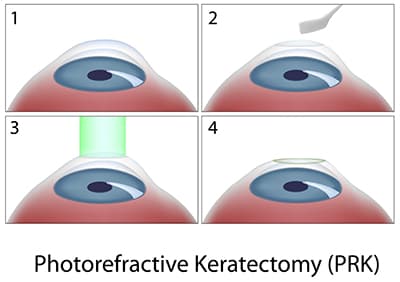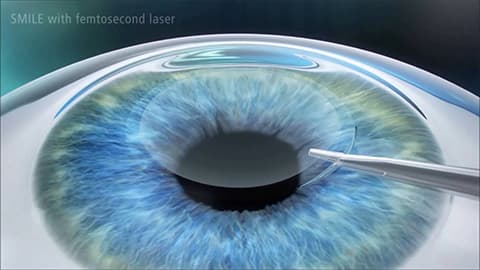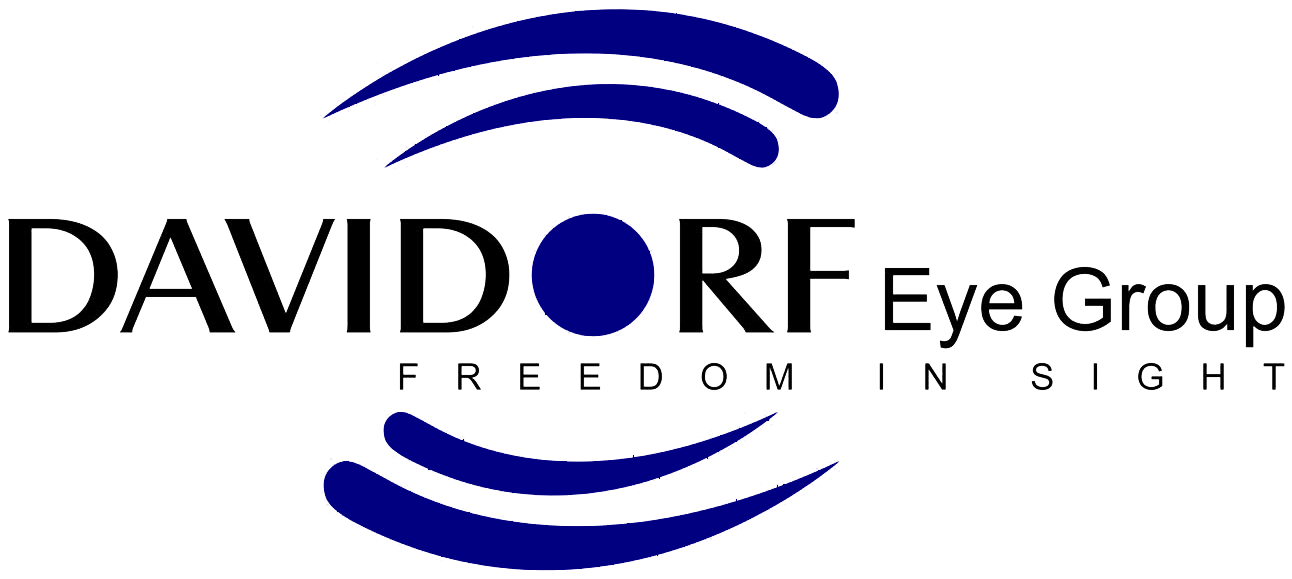
If you are not a good candidate for LASIK you may be a candidate for a procedure known as photorefractive keratectomy or PRK. PRK offers the same visual outcomes as LASIK and has dramatically improved the vision of millions of people who were unable to have LASIK. PRK is also known as LASEK (pronounced LAS-ECK), epi-LASIK, and surface ablation.
PRK
Like LASIK, PRK is a refractive surgery that uses the same excimer laser to reshape the cornea. Instead of creating a flap and then reshaping the deeper corneal layers, PRK works directly on the surface layers of the cornea. Consider it as LASIK without the flap.
As with LASIK, For mild to moderate myopia, only 5% to 10% of the corneal thickness is removed. For extreme myopia, up to 30% may be removed. If you were to measure this tissue, its thickness would be that of one to three human hairs.
The major advantage of PRK is that, by staying more superficial, it maintains the structural integrity of the cornea. The calculation as to the laser’s affect on corneal strength becomes most relevant for patients with thinner or irregularly shaped corneas.
History of PRK
First introduced in 1987, PRK was approved by the U.S. FDA in 1995. No microkeratome is used to create a corneal flap. Instead, the eye surgeon uses the laser to reshape the cornea one microscopic layer at a time. As public awareness of LASIK grew, PRK lost popularity because of the greater comfort and faster recovery of vision offered by LASIK.
Over the past decade, a newer generation of excimer lasers and more refined techniques have reduced the risks of PRK. Today, PRK patients tend to have an easier recovery. This has made PRK the preferred option for many patients whose needs would not be met by LASIK.
Who Is a Candidate for PRK?
Most people who are candidates for LASIK are also candidates for PRK. The PRK procedure is an especially good fit for people with mild to moderate nearsightedness, farsightedness, and/or astigmatism.
Individuals with thin or irregularly shaped corneas may be better candidates for PRK than for LASIK. As with any laser surgery, your corneas should be healthy, and your vision should be stable for at least a year prior to the procedure. Also, except in certain situations, you need to be at least eighteen years of age to undergo this procedure.
Who Is Not a Candidate for PRK?
Anyone with an active outbreak of herpes simplex of the eye cannot have PRK. If you go six months without a recurrence of it, some doctors will do PRK, giving you prophylactic medications before and after the procedure to lower the risk of a herpes simplex recurrence during recovery.
In general, pregnant women should avoid PRK and all vision correction procedures because pregnancy sometimes destabilizes one’s prescription during the third trimester. If your pregnancy is in an early stage and your vision hasn’t changed, you may be able to have PRK.
If you suffer from any major medical conditions, for example, diabetes, or an autoimmune disease such as lupus or rheumatoid arthritis, it does not automatically disqualify you for PRK. You can talk with us about taking some specific steps to make PRK as safe as possible for you.
Preparing for PRK

To give your eyes time to return to their natural shape and thus allow for more accurate vision correction, we will ask you not to wear contact lenses for one week before the date of your eye measurements.
If you wear rigid, gas-permeable contact lenses, we will ask that you not wear them for two to three weeks before your measurements, for the same reason.
Whether to treat both eyes on the same day or to treat each eye on different days is a decision you and Dr. Davidorf can make together. Because the return of functional vision is delayed after PRK, some surgeons prefer to wait at least a week before treating the second eye. The main drawback of that is the inconvenience of going through two recovery periods — each with 24 to 48 hours of pain or discomfort — and coming into the office for the extra postoperative office visits.
Travel arrangements following PRK surgery are necessary, as you will be given a mild sedative prior to surgery.
LASEK
Laser Epithelial Keratomileusis (LASEK) is similar to PRK because it doesn’t involve the creation of a traditional corneal flap like LASIK. Unlike PRK, instead of removing and discarding the temporarily surface cells (the epithelium), this thin layer of protective skin that covers the cornea is loosened with a special solution and moved aside.
The excimer laser is then used to reshape the cornea during the procedure (identical to LASIK and PRK), and the epithelial flap is returned to its original position. Using this layer as a natural bandage, as opposed to removing that temporary layer as with PRK, the postoperative discomfort can be lessened. Like PRK, the healing time for LASEK is longer than LASIK because the treatment is performed on the surface of the eye.
While new, healthy surface cells (epithelium) regenerate over a 3-5 day period of time, a soft, clear, bandage contact lens is kept in the eye to ease the recovery. Even though LASEK has a long recovery time than LASIK, the ultimate post-operative results are Patients may choose to have LASEK rather than LASIK for a variety of reasons.
The difference between LASEK and PRK is that the epithelial layer is removed and discarded during PRK, but it is removed and replaced during LASEK. After the procedure, new corneal cells will replace the ones removed during the surgery. The natural sloughing off and regeneration of corneal surface epithelial cells is something that happens continually, every day, to all of us.

SMILE Procedure
Small Incision Lenticule Extraction with SMILE is the most recently developed type of laser eye surgery. It’s a minimally invasive procedure that can correct various vision impairments such as nearsightedness and astigmatism.
It’s a popular option, with over 900 clinics and 1800 practicing surgeons worldwide who use SMILE. By June 2020, myopia and/or astigmatism were corrected with SMILE in more than 3.0 million eyes in over 70 countries.
How does SMILE work?
SMILE is running on a femtosecond laser to reshape the cornea. This femtosecond laser is an extremely short-pulsed, near infrared laser often also used to create a LASIK flap. The laser’s high peak intensity over a very short pulse duration (within a few femtoseconds of time) allows it to create micro-precision single holes (bubbles) that forms together cuts or planes in the corneal tissue without affecting the surrounding tissue.
It takes an average of 23 seconds for the laser to create a small lens-shaped piece of corneal tissue (called the lenticule) inside the cornea. The surgeon then removes the lenticule through a small incision outer part of the eye. This reshapes the cornea and corrects the refractive error.
The femtosecond laser produces a thin layer just beneath the surface of the eye, and at the same time creates a small opening. It’s an almost silent, noiseless, odourless procedure and the patient can remain in the same position from start to finish.
Who is eligible for SMILE?
SMILE is designed to correct myopia, astigmatism or a combination of the two, but is currently not an option for farsightedness (hyperopia) yet. The nature and degree of the refractive error, and the curvature and thickness of the cornea also play a role.
Your profession and hobbies are also important. If you often participate in strenuous contact sports, your doctor might recommend a treatment with SMILE. As with other laser vision correction methods, you will first need to undergo a detailed eye examination to determine whether you are a suitable candidate.
Refractive Lens Exchange (RLE)
As we age, the natural lens of the eye has a harder time adjusting focus. During our 40’s the focusing trouble begins to manifest as a need for reading glasses, a condition known as “Presbyopia.” The lens changes progress over time as does our need for glasses (the beginning of “Dysfunctional Lens Syndrome”). Eventually, the increasingly dysfunctional natural lens becomes discolored or cloudy. When the lens changes are significantly affecting vision, cataract surgery is indicated. Refractive Lens Exchange (RLE; sometimes called Clear Lens Exchange – CLE) involves removing the eye’s lens, just like in cataract surgery, but it’s performed before a significant cataract develops. This is done with a special aspiration instrument (with or without ultrasound or laser assistance) using only eyedrop anesthesia, (similar to LASIK). A flexible synthetic lens implant of the proper power is then placed inside the eye through an extremely small incision to correct the refractive error, enabling patients to see without the need for glasses and contact lenses.
This outpatient procedure is typically pain-free, takes 20 minutes or less to perform, and is normally completed without sutures. Visual recovery is quite rapid. As with LASIK, most refractive lens exchange patients are able to return to work the day following their procedure.
Refractive Lens Exchange (RLE)Astigmatic Keratotomy (AK) or Limbal Relaxing Incision (LRI)
This procedure is used to correct pure astigmatism. Typically, one or two very fine incisions are made in the peripheral cornea to allow the cornea to assume a more spherical shape (as if loosening the laces on a football). This procedure has a long track record and is a great option for patients with lower levels of astigmatism but without coexisting nearsightedness or farsightedness. The procedure takes just a few minutes to perform, is painless, and offers patients rapid visual results.
The most frequent use of AK/LRIs currently is for correction of astigmatism at the time of lens implant surgery (either cataract or refractive lens exchange surgery). The procedure also has good utility for fine tuning the vision in patients who have already undergone lens based surgery (RLE or Cataract Surgery)
EVO ICL
For the correction of the most extreme levels of nearsightedness and astigmatism, the procedure of choice is the implantation of a contact lens-like material inside the eye. Unlike cataract surgery or Refractive Lens Exchange surgery, the natural lens is not removed with EVO ICL implantation; rather, the implant sits in front of the natural lens. In effect, the contact lens implant becomes an internal contact lens. EVO ICL patients enjoy a similar quick recovery as other refractive patients (LASIK, Refractive Lens Exchange for example).
Implantable Contact Lens (ICL)Corneal Inlays
Corneal inlays are small lenses that can be surgically implanted within a patient’s cornea (instead of placed/worn on top of the cornea like a contact lens) in order to change the focusing of the patient’s eye. With newer techniques of implanting the lenses and refined lens designs, corneal inlays have started to gain traction as a reasonable treatment option for very specific types of patients. The ideal candidate for a corneal inlay is someone who has excellent distance vision but is tired of constantly reaching for their reading glasses (usually in patients over the age of 48).
Corneal InlaysConductive Keratoplasty (CK)
If you find yourself needing reading glasses to see up close, a procedure called conductive keratoplasty (CK) may help restore your vision. During the CK procedure, a handheld probe is used to send radio waves to specific spots on the cornea, altering its shape to correct your near vision. CK can be performed on one or both eyes in order to give you near and distance vision without glasses (monovision). CK is most commonly used for patients with lower corrections.
CK requires no laser or surgical blade, however, CK patients may require additional treatments.



